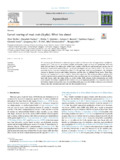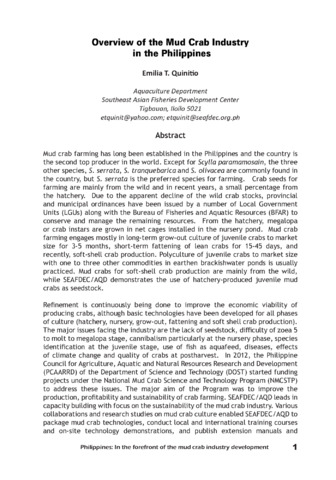Perlihatkan publikasi sederhana
Pond culture of mud crab Scylla serrata (Forskal) fed formulated diet with or without vitamin and mineral supplements
| dc.contributor.author | Triño, Avelino T. | |
| dc.contributor.author | Millamena, Oseni M. | |
| dc.contributor.author | Keenan, C. P. | |
| dc.date.accessioned | 2014-01-16T10:42:23Z | |
| dc.date.available | 2014-01-16T10:42:23Z | |
| dc.date.issued | 2001 | |
| dc.identifier.citation | Triño, A. T., Millamena, O. M., & Keenan, C. P. (2001). Pond culture of mud crab Scylla serrata (Forskal) fed formulated diet with or without vitamin and mineral supplements. Asian Fisheries Science, 14(2), 191-200. | en |
| dc.identifier.issn | 0116-6514 | |
| dc.identifier.uri | http://hdl.handle.net/10862/1914 | |
| dc.description.abstract | The effects of three diets (Diet 1 – with vitamin and mineral supplements, Diet 2 – without vitamin and mineral supplements, and Diet 3 – fish bycatch) and monosex culture (male or female) on the growth, survival, feed conversion ratio (FCR), and production of mud crab Scylla serrata were investigated using a 2 x 3 factorial experiment with three replicates per treatment. Juvenile mud crabs were stocked at 1.0·m-2 in 150 m2 ponds and reared for 156 days. Results showed no significant interaction between monosex culture and diets (P > 0.05) so that data were pooled by sex and dietary treatment. Mean final body weight of male crabs (427 g) was significantly higher (P < 0.05) than female crabs (400 g). However, crab carapace length (CL) and width (CW), specific growth rate (SGR), FCR, survival, and production were not significantly different (P > 0.05) between the two sexes. Regardless of sex, crabs fed fish bycatch (Diet 3) gave significantly higher (P < 0.05) mean body weight (435 g) than those fed Diet 2 (395 g). Mean final body weight (410 g) of crabs fed Diet 1 was not significantly different from those fed Diets 2 or 3. The CL and CW, SGR, FCR, survival, and production of mud crabs fed the three diets, however, were not significantly different (P > 0.05). The economic viability of using a diet without vitamin and mineral supplements was comparable to that of a complete diet having about the same cost of production and return on investment of 74 to 75%. The study shows that cost-effective formulated diet could be used as alternative feed for fish bycatch thus saving on feed and storage costs. | en |
| dc.description.sponsorship | This study was funded by SEAFDEC/AQD and ACIAR under ACIAR Project No. 9217. | en |
| dc.language.iso | en | en |
| dc.publisher | Asian Fisheries Society | en |
| dc.relation.uri | http://www.asianfisheriessociety.org/publication/pdf/0548907001355881230.pdf | |
| dc.subject | Scylla serrata | en |
| dc.title | Pond culture of mud crab Scylla serrata (Forskal) fed formulated diet with or without vitamin and mineral supplements | en |
| dc.type | Article | en |
| dc.citation.volume | 14 | |
| dc.citation.issue | 2 | |
| dc.citation.spage | 191 | |
| dc.citation.epage | 200 | |
| dc.citation.journalTitle | Asian Fisheries Science | en |
| seafdecaqd.library.callnumber | VF SJ 0674 | |
| seafdecaqd.databank.controlnumber | 2001-23 | |
| dc.subject.asfa | artificial feeding | en |
| dc.subject.asfa | crab culture | en |
| dc.subject.asfa | diet | en |
| dc.subject.asfa | economic feasibility | en |
| dc.subject.asfa | feeding experiments | en |
| dc.subject.asfa | growth | en |
| dc.subject.asfa | pond culture | en |
| dc.subject.asfa | survival | en |
| dc.subject.scientificName | Scylla serrata | en |
Files in this item
| Files | Size | Format | View |
|---|---|---|---|
|
There are no files associated with this item. |
|||
Publikasi ini ada di koleksi berikut
-
Journal Articles [1256]
These papers were contributed by Department staff to various national and international journals.



